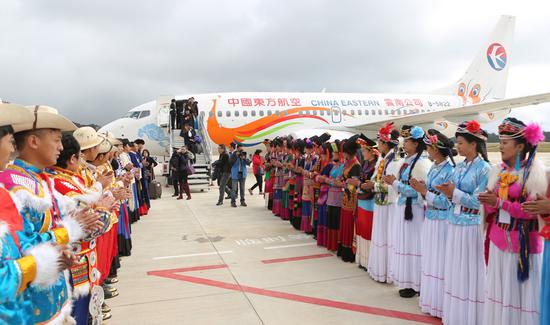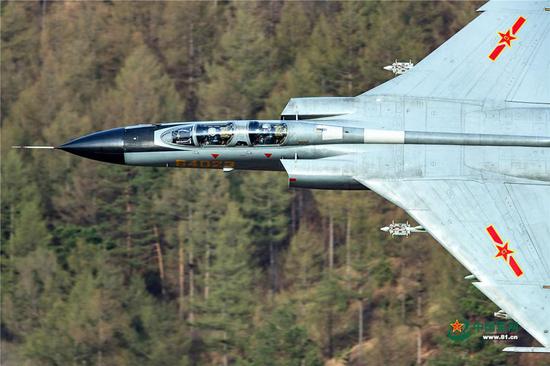
aa
More domestic airlines are launching new flights connecting less-densely populated smaller Chinese cities, and those areas are seeing more remarkable growth in air traffic than major cities.
Last year, the airports of Quanzhou in Fujian province, Nantong, Changzhou and Xuzhou in Jiangsu province, Jieyang in Guangdong province and Yichang in Hubei province saw their annual passenger throughput reach 2.5 million, a jump of more than 30 percent year-on-year, according to data from the Civil Aviation Administration of China.
In 2018, passenger throughput growth of major cities' airports was less than 10 percent year-on-year, while the growth rates of a number of third - and fourth-tier cities' airports were higher than 20 percent, the data showed.
"It's key for carriers to seize good flight times. Many domestic airlines would like to launch flights to major cities like Shanghai, Nanjing and Hangzhou, but flight times available in first - and second-tier cities are quite tight," said Li Xiaojin, a professor of aviation economics at the Civil Aviation University of China in Tianjin.
"Instead, by launching new flights at smaller cities, airlines may be able to realize net profits after two to three years of operations. In the beginning stage, there are usually some favorable policies in price and services. In the next few years, the flight times available at those smaller airports may become precious, as well," he said.
Shanghai-based Chinese budget carrier Spring Airlines has established three strategic bases since 2017. They are the airports in Yangzhou, Jiangsu province, Ningbo, Zhejiang province, and Shantou, Guangdong province, in addition to its main hub airports in Shanghai. Without much competition from major State-owned airlines, Spring has achieved significant room for growth of launching more flights.
In summer and fall flying seasons of last year, about three quarters of Spring's flights departed from third-tier cities. Spring has a promising prospect, driven by the growing passenger demand from smaller cities, according to a research report of Changjiang Securities.
"We also focus on developing other markets besides Shanghai, by following strategies of differentiated competition, and to further tap the huge demand emerged from potential markets," said Zhang Wu'an, vice-president and spokesman for Spring Airlines.
"For domestic flights, the newly added flight times at first-tier airports were quite scarce last year, and the scale expansion of second-tier airports was slowing down. Facing the bottlenecks of capacity increase, we need to build a more diverse and tridimensional flight network and hub structure," he said.
In the meantime, Shandong province in East China will spend 430 million yuan ($64 million) this year to support the infrastructure building and service improvement of its airports in Jinan, Dongying, Yantai, Weifang, Jining, Weihai, Linyi and Rizhao, according to Shandong Province Finance Bureau.
Particularly, the local government said it will spend 4.8 million yuan to subsidize small and medium-sized airports - with annual passenger throughput of less than 2 million - to alleviate their operational and financial pressures.
"Since 2015, the local government has accumulatively provided 210 million yuan to support operations of Yantai airport, and its passenger throughput has expanded by 25 percent annually," the local government said in a statement.
Meanwhile, in Yunnan province in Southwest China, the local government recently posted a new planning framework. The statement said that by 2030, Yunnan, with 15 civil airports in the region, aims to achieve an annual passenger throughput of 150 million, and the output value of the aviation sector in the province is expected to reach 100 billion yuan.
Changshui International Airport in Kunming, the provincial capital of Yunnan, is expected to become an international air transport hub with convenient connections to Southeast Asian countries, the statement said.
China Eastern Airlines has established a branch in the province named China Eastern Yunnan Airlines. The carrier launched flights from Kunming to tourism cities including Lijiang, Dali, Shangri-La, Xishuangbanna and Tengchong. In the summer and fall this year, the carrier will operate 175 domestic flights in the Yunnan market.
"Fueled by social economic development of Yunnan, China Eastern has continuously expanded our fleet size in the region," said Zhang Hong, secretary of the Party committee of China Eastern Yunnan Airlines.
"We have launched a number of international flights connecting Kunming with 25 foreign cities, including many new flights connecting Kunming with countries and regions involved in the Belt and Road Initiative," he said.
Stefano Bortoli, CEO of European turboprop manufacturer ATR, earlier said that the growth of the regional aircraft market in China is still in its infancy, and there is considerable growth potential. The company said it is in discussions with potential customers, and its first customer is likely to appear in Yunnan.
Last year, Lijiang Sanyi International Airport, located in renowned tourism city Lijiang, Yunnan, transported 7.53 million people and achieved sales revenues of 352 million yuan. It has been making profits for six consecutive years, according to the local government.
By 2020, the Lijiang airport aims to transport 11 million people, and by 2045, it aims to transport 22 million people. Now, the airport stands as one of the fastest-growing and busiest regional small airports in China, and it plans to become the first 10-million level regional airport nationwide.
In addition, Yunnan province plans to develop an aviation manufacturing industry based on equipment production, maintenance and general aviation. The region will also develop an air service industry, air logistics, and a potential aviation industrial park.
Industry experts said local governments usually provide financial aid to support the development of air transportation. For local governments, it would bring better images for a city if it had an airport and multiple flights. It would also help to attract investments and travelers, boosting regional tourism.
"China is developing a regional aviation model with its own features. In the beginning stage, subsidies from local government play an important role to reduce uncertainties. Most plateau airports globally are located in western China, and the country is a great market with rich opportunities for the growth of the regional aviation sector," said Li Guijin, a professor at the Civil Aviation Management Institute of China.
"Smaller regional airlines should cooperate with major full-service airlines, such as the cooperation in code sharing. The collaboration between Air China and regional airline China Express is a positive example. In the United States, nearly all the major full-service airlines and regional smaller airlines cooperate comprehensively," he said.
He added that there exists multiple growth opportunities for smaller airlines. For example, Beijing Daxing International Airport, which is expected to start operation in September, could provide a chance for smaller airlines in the surrounding areas, such as Hebei Airlines. They should seize the growth opportunities emerging from the new airport, he said.


















































